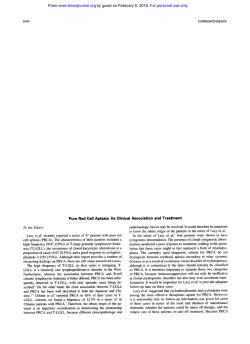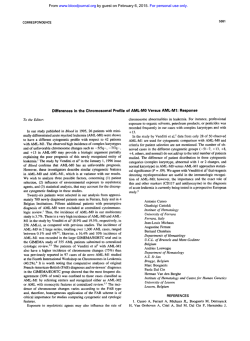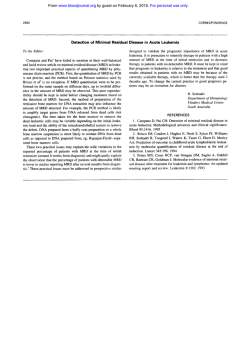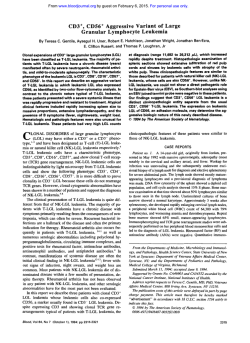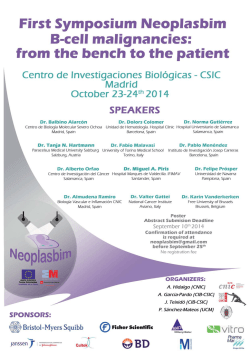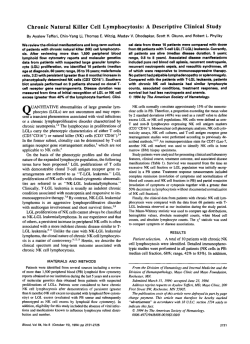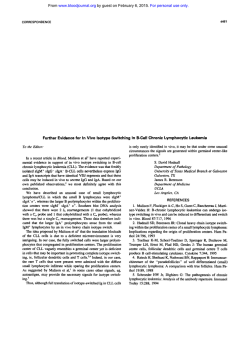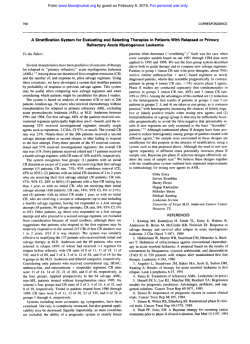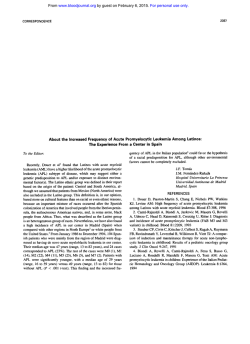
Pure Red Cell Aplasia: Association With Large Granular
From www.bloodjournal.org by guest on February 6, 2015. For personal use only. Pure Red Cell Aplasia: Association With Large Granular Lymphocyte Leukemia and the Prognostic Value of Cytogenetic Abnormalities By Martha Q. Lacy, Paul J. Kurtin, and Ayalew Tefferi From 1980 through 1994, we identified 47 adult patients netic abnormalities. Therewas a trend toward superior rewith acquired pure red cell aplasia (median age, 64 years; sponse to immunosuppressive agents in the patients with range, 22 to 84 years). Associated clinical disorders included T-cell LGL leukemia.Cyclophosphamide, with or without T-cell large granular lymphocytic(LGL)leukemia, thymoma, corticosteroids, was the mostuseful treatment agent. chronic lymphocytic leukemia, and non-Hodgkin‘s lymCyclosporine A was effective for refractory disease,Neither phoma. Review of bone marrow findings in 40 patients the presence of an associated clinical disorder northe exisshowed absence of erythroid precursors in 14 patients and surtence ofdetectableerythroid precursors affected overall rare pronormoblasts in 26. None had morphologic evidence vival. We conclude that (l) T-cell LGL leukemia isthe disorof myelodysplasia. T-cell receptor gene rearrangement stud-der most commonly associated with pure red cell aplasia, ies with Southern blot technique in 14 patients showed (2) the presence of clonal cytogenetic abnormality predicts clonalrearrangements in nine.Karyotypicanalysesperpoor response to immunosuppressive therapy, and (3) oral formed in 28 patients showed clonal abnormalities in four. cyclophosphamideandcyclosporineAareeffective treatOverall, 28 of 47 patients (60%) responded to immunosupment regimens. pressive therapy, but none were the patients with cytoge0 7996 by The American Society of Hematology. P URE RED CELL aplasia (PRCA)is a rare hematologic syndrome characterized by anemia, reticulocytopenia, and severe erythroid hypoplasiaof the bone marrow associated with quantitatively and qualitatively normal megakaryocytic and myeloid cell lines. In children, the syndrome is often congenital and referred to as Diamond-Blackfan anemia. Acquired PRCA in children is usually self-limited and referred to as “transient erythroblastopenia of childhood.” In adults, most of the cases are idiopathic, and the rest have been associated with lymphoproliferative disorders, parvovirus infections, and thymomas. When PRCAmarrow cells areassayed in semisolid media, 60% have a normal number of assayable erythroid progenitors.’ Increased erythropoietic proliferative capacity in vitro is correlated with therapeutic response to immunosuppressive The ability to proliferate in vitro, but not in vivo, is a notable feature of PRCA and suggests aninhibitor in vivo that blockserythropoiesis.Humoralmechanisms havebeen demonstrated in vitro,includingsuppression of heme synthesis, inhibition of colony-forming units-erythroid (CFU-E) and burst-formingunits-erythroid (BFU-E), and direct cytotoxicity to pronormoblasts.’-’ For the patients with PRCA in whom an IgG inhibitor cannot be demonstrated, lymphocyte-mediated inhibition of erythropoiesis isthoughttobe themajor mechanism of pathogenesis.Earlyinvestigations of apatientwithT-cell chronic lymphocytic leukemia showed that blood lymphocytes inhibited normal marrow CFU-E growth,an effect that could be abolished by marrow treatment with antithymocyte globulin and complement.’ Subsequently, T cells with recepFrom the Division of Hematology and Internal Medicine and the Division of Patholog.y, Mayo Clinic and Mayo Foundation, Rochester,MN. Submitted June 20, 1995; accepted November 15, 1995. Address reprint requests to Ayalew Tefferi, MD, Mayo Clinic,200 First St SW, Rochester, MN 5.5905. The publication costs of this article were defrayed in part by page chargepayment. This article must thereforebeherebymarked “advertisement” in accordance with 18 U.S.C. .section 1734 sole1.v lo indicate this fact. 0 1996 by The Americun Society of Hematology. 0006-4971/96/8707-00I9$3.00/0 3000 tors for the Fc portion of IgG molecule (Ty) were shown to have an inhibitory effect on CFU-E.” A similar inhibition of erythropoiesis in vitro by large granular lymphocytes has also been demonstrated.”.” In patients with B-cell chronic lymphocytic leukemia and PRCA, an increased percentage of Ty cells wasfound in marrowaspirates and shown to inhibitthe growth of erythroid colonies in vitro. CFU-E growth markedly increased after removal of the Ty cells by E-rosetting.” PRCA secondary to parvovirus B 19 is thought to be due to a direct toxic effect of the virus on pronormoblasts. Serum that contains this DNAvirus inhibits CFU-E growth in vitro, an effect that can be inhibited by antibody to the virus.“.” Also, virus has been identified in proliferating CFU-E. The aforementioned observations suggest a heterogeneous pathogenetic mechanism in adult PRCA. Clinically,the natural history of the disease, the associated conditions, and its response to treatment are incompletely understood, mainly because most published series are small. Also, few reports include long-term follow-up information. The report of the largest series to date has suggested that in most patients the disease responds to immunosuppressive therapy, and that PRCA is a chronic, relapsing disease with a median survival time greater than I O years.“ Nevertheless, in a substantial number of patients, the disease fails to respond to therapy, with long-term survival less than the median. Identification of prognostic factors would be useful in counseling patients and in planning treatment. We reviewed the 14-year-long experience at our institution with adultPRCA. Giventhe known associations of PRCA with thymomaandchroniclymphocytic leukemia, we were particularly interested in looking for an association with lymphoproliferative disorders. We also sought to identify potential prognostic factors and toreview response rates to various treatment regimens. MATERIALS AND METHODS We identified 47 patients who were evaluated at our institution between 1980 and 1994 for acquired PRCA. The cases of five of these patients have been included in previous report^.""^ Patients with Diamond-Blackfan anemia or transient erythroblastopenia of childhood were excluded. The medical histories of the patientswere reviewed retrospectively, and pertinent clinical and laboratory data Blood, Vol 87, No 7 (April l ) , 1996: pp 3000-3006 From www.bloodjournal.org by guest on February 6, 2015. For personal use only. 3001 PURE RED CELL APLASIA Table 1. Conditions Associated With PRCA in 47 Patients PR, no. Overall Response Rate% 2 56 88 50 No. of Clinical Association Idiopathic 12 T-cell large granular leukemia lymphocytic Thymoma Chronic lymphocytic leukemia Non-Hodgkin‘s lymphoma Abnormal cytogenetics Patients CR. no. 25 9 6 2 4* 1 l 4 3 1 0 2 4 0 0 0 75 50 Abbreviations: CR. complete response; PR, partial response. * One of the patients also had large granular lymphocytic leukemia. were abstracted. Cytogenetic analysis and T-cell receptor (TCR) gene rearrangement studies with Southern blot technique are offered as routine clinical tests at our institution, and whenever available, the results of these investigations were recorded. Follow-up data were obtained by contacting the patient or his or her personal physician. All the patients had bone marrow aspirates and biopsies performed, and the findings were reviewed by one of our hematopathologists at the time of evaluation. Bone marrow specimens from 40 of the patients were available for rereview by a single hematopathologist (P.J.K.). The diagnosis of PRCA was made if the patient presented with a severe anemia and reticulocytopenia, the bone marrow aspirate and biopsy showed absence of erythrocyte precursors on maturation arrest atthe pronormoblastic stage, and the leukocyte and platelet counts were normal. A diagnosis of large granular lymphocytic (LGL) leukemia was made if the patient had evidence of a clonal TCR gene rearrangement and lymphocyte phenotyping, either by immuohistochemical techniques or flow cytometry, confirmed the LGL phenotype. In three cases, patients with clonal TCR gene rearrangements did not have lymphocyte phenotyping available. In these patients, the diagnosis wasmade by finding large granular lymphocytes in the peripheral blood smear and by excluding other T-cell malignancies on clinical grounds. Patients with morphologic evidence of dysmyelopoiesis were excluded. A “complete response” was defined as a hemoglobin concentration greater than 11 g/dL sustained without transfusions. A “partial response” was defined as a hemoglobin concentration less than 11 g/dL in a patient who became transfusion independent. Two-sided x* tests were used to determine significance levels among different groups of patients with regard to treatment outcome. Survival data were estimated with the Kaplan-Meier method. RESULTS Patient Characteristics Forty-seven patients who met the pathologic criteria for the diagnosis of PRCA were identified. All these patients were profoundly anemic for at least 1 month, and all required transfusions of packed erythrocytes at some time. There were 28 malesand 19 females, the median age was 63 (range, 22 to 88 years). The median hemoglobin concentration at presentation was 6.3 g/dL (range, 3.0 to 8.4 g/dL), with a median retriculocyte count of 0.1 % (range, 0.1% to 0.6%). All patients had radiographic examination or computed tomographic (CT) scans of the chest to look for thymoma. The median follow-up periodwas 4.5 years (range, 0.5 to 13 years). Nine patients had T-cell LGL leukemia, four had chronic lymphocytic leukemia, two had non-Hodgkin’s lymphoma, and four had thymoma (Table 1). One of the patients with thymoma also had LGL leukemia and, for the purposes of this review, was grouped with the LGL leukemia patients. Four patients had abnormal karyotypes. The karyotypic abnormalities are listed in Table 2. The 25 other patients were classified as having idiopathic PRCA. Acute leukemia did not develop in any of the patients. In one patient, the onset of PRCA coincided with the resection of the thymoma. In two other patients, PRCA coincided with recurrences of unresectable invasive thymomas. Thymoma was discovered in a fourth patient when he presented with PRCA. Although his thymoma was resected, his PRCA did not improve. One year later, he underwent peripheral blood lymphocyte phenotyping and was found to have a preponderance (86%) of CD3+/CD8+ lymphocytes. Subsequent TCR gene rearrangement studies confirmed clonality. Laboratory and Pathologic Review Bonemarrow specimens from 40 of the patients were available for review. Fourteen patients had an absence of erythroid precursors (Fig 1). Twenty-six patients had maturation arrest at the level of pronormoblasts (Fig 2). Three patients had giant pronormoblasts and vacuolations suggestive of parvovirus infection, and eight hadbonemarrow eosinophilia. None of the patients had morphologic evidence of myelodysplasia, as defined by the French-American-British Cooperative Group.’’ Furthermore, on the basis of bone marrow morphology alone, it was difficult to identify prospectively those patients withLGL leukemia. The clonal LGLs were always a minor bone marrow cell population, accounting for 5% or less of the bone marrow cellularity. The median hemoglobin concentration at presentation was 6.9 g/dL (range,3.0 to 8.4 g/dL). The median reticulocyte count was 0.1% (range, 0.0% to0.6%).Themedianplateletand leukocyte countswere normal. The patients who had abnormalities involving platelets or leukocytes had chronic lymphocytic leukemia or LGL leukemia. Bloodor bone marrow specimens (or both) from14 patients were tested for TCR gene rearrangements. The specimens from nine patients showed clonal rearrangementof TCR-P (Fig 3 and Table3).Peripheralblood lymphocyte phenotyping, either with immunohistochemistry or flow cytometry, was available in six of the patients with rearranged TCR gene and confirmed the LGL phenotype. Five patients had lymphocytes positive for CD2 or CD3. Four of these patients were also positivefor CD8, and one was positive for CD57. The lymphocytes from one patient expressed CD57, but were not typed for CD2 or CD3. Twenty-eight patients had cytogenetic analyses,and four had clonal karyotypic abnormali- Table 2. Cytogenetic Abnormalities Detected in Four of 28 Patients Tested who had PRCA ~ Cytogenetic Abnormality’ de1(20)(q11.2q13.1) delX~pll.2),-2;der(5),t~5;?)(q13;?~,+rnar(l8~ t(1;5)(p36;q35) -5,de1(5)(q15),+21 * In one patient each. ~___ From www.bloodjournal.org by guest on February 6, 2015. For personal use only. LACY, KURTIN, AND TEFFERI 3002 I . i f Fig l. Bonemarrowaspirate fromone of 14 patients with PRCA and absence of erythroid precursors. ties. Eght patients had serologic studies for parvovirus IgM, and none were positive. Results of Treatment Because this was a retrospective review, the patients did notreceiveuniformtreatment.Mostpatientsinitiallyreceived treatment with corticosteroids followed by various forms of immunosuppressive therapy until a response was achieved. Doses varied, but a typical starting dose was 0.5 to 1mgikg prednisone or its equivalent. Among the patients receiving cytotoxic therapy, most received cyclophospha- Fig 2. Bone marrow aspirate from patient with PRCA. Note ram pronormoblast$. I mide with or without prednisone. The doses of cyclophosphamide varied from 25 to 100 mg daily. One patient receivedcombinationchemotherapyconsistingofcyclophosphamide, vincristine, and prednisone. One other patient receivedchlorambucilwithprednisone.Fivepatientsin whom corticosteroids or cytotoxic therapy failed, received cyclosporineA. Of these five patients, four had starting doses of 12 mgkg in divided doses. The other patient had an initial dose of 150 mg twice daily. The dose of cyclosporineA was tapered as tolerated. Overall, 28 patients (60%) had a responseto immunosup- From www.bloodjournal.org by guest on February 6, 2015. For personal use only. PUREREDCELLAPLASIA l 2 3 4 5 6 Fig 3. Autoradiographs of the TCR gene rearrangements digested with Ecom and hybridized with the JP, probe. Lane 1 shows the pattern of a normal control subject. The arrow indicates that 11-kb germline fraction. Lanes 2 through 6 demonstrate rearrangements in five of the patients with PRCA. Similar rearrangements were found in another four patients. pressive therapy. After the patients with cytogenetic abnormalities were excluded, the response rate in the group was 65%. Among the 25 patients who received corticosteroids as first-line therapy, responses were seen in nine. The median time to response was 1.4 months (range, 1 to 3 months). Four other patients were given corticosteroids after having no response to other modalities; none of these patients had a response. Cytotoxic agents with or without corticosteroids were used as first-line therapy in IO patients, five of whom had a response. Also, 15 other patients received cyclophosphamide after having no response to corticosteroids or other therapies, and eight of these patients had a response to cyclophosphamide. The mediantime to response in this group was 2.1 months (range, 1 to 3 months). All the patients who had treatment with cyclosporine A received it as second- or third-line therapy after failing to respond to corticosteroids or cytotoxic agents. Three of these patients had a response to cyclosporine A given initially at doses of 12 mgkg, and one had a response to a dose of 150 mg twice daily. In all the patients who had a response, cyclosporine A was tapered as tolerated, and three patients have required ongoing maintenance therapy with low doses of the drug. All the patients whohad a response to cyclosporine A hadit in thefirst month of treatment. Two spontaneous remissions occurred, both in patients with idiopathic PRCA. The PRCA in these patients was not thought to be drug-induced, and the remissions were not associated with drug withdrawal. Six of the 28 patients who had a response, including the five who initially received treatment with corticosteroids alone, had a relapse when treatment was discontinued. Five of these six patients wenton to achieve a second remission. The sixth patient refused further therapy. None of the patients with a response to cytotoxic agents had relapse. Fourteen patients achieved 3003 a response to their first therapy; most of the patients required more than one type of treatment. The responses by various clinical groups are listed in Table 1, and the results of all the regimens used are listed in Table 4. The median survival time for the group was 12 years. Amongthe 47 patients, there were 13 deaths. Eight of these resulted from failure of the PRCA, torespond to therapy, with resultant iron overload and organ dysfunction. Two patients died of progressive CLL. One patient died of progressive malignant thymoma. Two patients died of unrelated medical problems. The patients with LGL leukemia had a better response to therapy than those with idiopathic PRCA (88% v 56%). However, this result does not reach statistical significance ( P = .07), and the difference in survival time between the two groups was not statistically significant. There wasno difference when comparing the response rates and median survival times between the patients who had an absence of erythroid precursors and those withrare pronormoblasts (57% v 50%; P = NS). None of the patients with karyotypic abnormalities achieved remission. DISCUSSION Our data and those in the literature support the concept that PRCA is pathogenetically heterogeneous. The blood and bone marrow findings are the final common pathway ofat least four different disease processes: ( I ) humoral inhibition of erythropoiesis, (2) suppression of erythropoiesis by clonal T cells, as in LGL leukemia, or by nonclonal T cells, as in chronic lymphocytic leukemia and thymoma, (3) karyotypic abnormalities of bone marrow stem cells that probablyrepresent a form of myelodysplastic syndrome, and (4)a direct toxic effect of parvovirus B19 on erythroid precursors. The association of PRCA with lymphoproliferative disorders is of interest because of the growing evidence that in a subset of patients withPRCAthe disease ismediated by clonal T-cell proliferations. The results of Mangan et all3 suggest that PRCA associated with chronic lymphocytic leukemiaismediated by T lymphocytes. Abkowitz et all2 clearly demonstrated T-cell-mediated inhibition of erythropoiesis in marrow culture systems from patients with PRCA. Sivakumaran et aIz0 reported two patients with PRCA who Table 3. TCR Gene Rearrangements Patient F G H I Specimen J01 Jbz Studied (EcoFiI or BarnHI) (EcoRI) BM PB PB PB BM PB PB PE PB PB + + + + + + TY (EcoRI) + + E t + G + + + ND ND ND G + G ND ND ND Abbreviations: BM, bone marrow aspirate; E, equivocal results; G, germline; ND, not done; PE, peripheral blood; +, rearrangement noted. From www.bloodjournal.org by guest on February 6, 2015. For personal use only. 3004 LACY, KURTIN, AND TEFFERI Table 4. Treatment Regimens for Patients With PRCA Response (no. of patients) Treatment Regimen RR Corticosteroids 9/29 5 CTX ? corticosteroids 13/25 (no. Associated Conditions of patients) Complete Partial Response No Response 6 3 Idio(5) LGL(3) NHL(1) 11 2 LGL(4) Idio(6) Idio(l1) LGL(4) Thy(2) Abn Cyto(3) Idio(4) LGL(3) Abn CytO(3) CLL(2) Abn cyto(1) CsA 415 Plasmapheresis 1l6 Androgens 0113 ATG Azathioprine 011 013 0 0 0 0 Methotrexate Splenectomy IVlG Erythropoietin Spontaneous Ill 011 112 o/ 1 2 1 0 1 0 1 0 0 0 0 1 Relapse (no. of patients) to Time Response lmo) 3 Thy(1) CLL(1) LGL(1) Idio(1) Thy(1) CLL(1) Idio(1) 1 - - - Idio(3) NHL(1) Abn cyto(1) Idio(8) LGL(1) NHL(1) Abn cyto( 1 ) Thy(1) Abn cyto(1) Idio(2) LGL( 1) Idio(1) LGL(1) 1 Idio(2) LGL(1) Idio(1) LGL(1) - Abbreviations: Abn cyto, clonal karyotypic abnormalities; ATG, antithymocyte globulin; CLL, chronic lymphocytic leukemia; CsA, cyclosporine A; CTX, cyclophosphamide; Idio, idiopathic; WIG, intravenous immune globulin; LGL, T-cell large granular lymphocytic leukemia; NHL, nonHodgkin’s lymphoma; RR, overall response rate; Thy, thymoma had TCR gene rearrangements that indicated T-cell clonality. Motoji et a12’ reported a case of LGL leukemia associated with PRCA. The TCR gene rearrangement could not be detected after the PRCA was treated successfully with cyclophosphamide. Hara et a12’ reported on a patient with PRCA and type I autoimmune polyglandular syndrome whohad rearrangement of TCRyS on Southern blot analysis and demonstrated that the TCRyS+ lymphocytes inhibited BFU-E in culture. Oshimi et alZ3reported on a series of 33 patients with LGL leukemia, four of whom metthe criteria (proposed by D e ~ s y p r i s for ~ ~ )the diagnosis of PRCA. Eight other patients in that series had clinical presentations identical to PRCA, but did not meet the pathologic criteria for PRCA. Dhodapkar et a l l 7 identified five patients with PRCA among 68 patients with T-cell LGL leukemia. In our series, LGL leukemia was the disorder most commonly associated with PRCA. Nine of the 14 patients tested showed clonal TCR gene rearrangements. It is possible that the association with LGL leukemia is even stronger than our data suggest, because most of our patients were examined before the Southern blots for TCR gene rearrangements were routinely available at our institution. In our experience, a clonal cytogenetic abnormality predicts a poor response to immunosuppressive therapy. It is raretofind a cytogenetic abnormality in association with PRCA, and nolarge series of such patients has been reported that might help to assess its clinical significance. There have been reports of two patients with PRCA associated with 5qkaryotypes, andneither of themhad a response to treatment.25.26Dessypris et a127reported a series of 31 patients with PRCA in whom chromosome analyses were performed and found one patient with an abnormal karyotype (47 + G). The patient had no response to immunosuppressive therapyand subsequently developed acute leukemia.” It is of interest to note that three of our four patients had abnormalities involving chromosome 5 and that the other patient had a 20q- abnormality, an abnormality associated with disorders of the erythroid series.28None of our patients and none of those described in the literature had a response to immunosuppressive therapy. We postulate that the PRCA seen in these patients is actually a form of myelodysplasia rather than secondary to autoimmune or lymphoproliferative disease and that such patients are unlikely to have a response to immunosuppressive therapy. Our data do little to elucidate the role of parvovirus B19 in the pathogenesis of PRCA. Only eight of our patients had IgM serologic studies for parvovirus, and none were positive. The data of Frickhofen et alZ9suggest that as many as 15% From www.bloodjournal.org by guest on February 6, 2015. For personal use only. 3005 PURE RED CELL APLASIA of cases of acquired PRCA are associated with parvovirus infection. This distinction is important because the treatment of choice for these patients would be immunoglobulin given intravenously rather than immunosuppressive therapy. Our data are consistent with those of Clark et all6 with regard to treatment regimens. In our experience, treatment with corticosteroids alone was of limited value. Only 30% of the patients had a response, and most of these were not durable responses. Three of nine patients who responded to corticosteroids were able to maintain remissions after corticosteroid therapy was stopped. The others either had a relapse and required cytotoxic agents or became dependent on corticosteroids. Thus, corticosteroids may still have a useful role in the treatment of PRCA, particularly in young people who may be spared the long-term consequences of cytotoxic therapy or treatment with cyclosporine A. However, most patients will require additional agents to achieve or to maintain remission. Treatment with cytotoxic agents, generally a combination of cyclophosphamide and prednisone, was effective in 50% of our patients. Of more importance, none of these patients had relapse. In our experience, androgens were of no benefit. On the basis of our data, plasmapheresis is seldom justified. The experience with antithymocyte globulin (ATG) presented here was very limited. However, Abkowitz et a1” found six of nine patients with PRCAimproved with use of ATG. Despite our small number of patients, we found the most effective agent was cyclosporine A. Four of the five patients who received this agent had a response. All of those who had treatment with cyclosporine A received it as second- or third-line therapy after not having a response to corticosteroids or cytotoxic agents. The only patient who did not have a response to cyclosporine A had a cytogenetic abnormality. Means et a13’ used a combination of cyclosporine A and corticosteroids and obtained responses in six ofnine heavily pretreated patients. Raghavacha?* summarized the experience reported in the literature with treating PRCAwith cyclosporine A and reported that the overall response rate was 65%. Therefore, consideration should be given to using cyclosporine A earlier to treat PRCA. In conclusion, we found that LGL leukemia is the disease most commonly associated with PRCA.This association predicts superior response to immunosuppressive therapy, but is not correlated with improved survival. We found that a cytogenetic abnormality predicts poor response to immunosuppressive therapy and that such patients may be better served by treatment strategies suitable for clonal myeloid disorders. The presence or absence of erythroid precursors in the bone marrow does not correlate with clinical outcome. Various immunosuppressive agents are effective in the treatment of PRCA. REFERENCES 1. Dessypris EN: The biology of pure red cell aplasia. Semin Hematol 28:275, 1991 2. Charles RJ, Sabo KM, Abkowitz JL: The pathophysiology of pure red cell aplasia (abstract). Blood 84:216a, 1994 suppl 1 3. Lacombe C, Casadevall N, Muller 0, Varet B: Erythroid progenitors in adult chronic pure red cell aplasia: Relationship of in vitro erythroid colonies to therapeutic response. Blood 64:71, 1984 4. Krantz SB: Pure red-cell aplasia. N Engl J Med 291:345, 1974 5. Krantz SB, Kao V: Studies on red cell aplasia. I. Demonstration of a plasma inhibitor to heme synthesis and an antibody to erythroblast nuclei. Proc Natl Acad Sci USA 58:493, 1967 6. Krantz SB, Moore WH, Zaentz SD: Studies on red cell aplasia. V. Presence of erythroblast cytotoxicity in G-globulin fraction of plasma. J Clin Invest 52:324, 1973 7. Browman GP, Freedman MH, Blajchman MA, McBride JA: A complement independent erythropoietic inhibitor acting on the progenitor cell in refractory anemia. Am J Med 61:572, 1976 8. Cavalcant J, Shadduck RK, Winkelstein A, Zeigler Z, Mendelow H: Red-cell hypoplasia and increased bone marrow reticulin in systemic lupus erythematosus: Reversal with corticosteroid therapy. Am J Hematol 5:253, 1978 9. Hoffman R, Kopel S, Hsu SD, Dainiak N, Zanjani ED: T cell chronic lymphocytic leukemia: Presence in bone marrow and peripheral blood of cells that suppress erythropoiesis in vitro. Blood 52:255, 1978 10. Nagasawa T, Abe T, Nakagawa T Pure red cell aplasia and hypogammaglobulinemia associated with Tr-cell chronic lymphocytic leukemia. Blood 57:1025, 1981 1I . Levitt LJ, Reyes GR, Moonka DK,Bensch K, Miller RA, Engleman EG: Human T cell leukemia virus-I-associated T-suppressor cell inhibition of erythropoiesis in a patient with pure red cell aplasia and chronic T gamma-lymphoproliferative disease. J Clin Invest 81:538, 1988 12. Ahkowitz JL, Kadin ME, Powell JS, Adamson J W : Pure red cell aplasia: Lymphocyte inhibition of erythropoiesis. Br J Haematol 63:59, 1986 13. Mangan KF, Chikkappa G , Farley PC: T gamma (T gamma) cells suppress growth of erythroid colony-forming units in vitro in the pure red cell aplasia of B-cell chronic lymphocytic leukemia. J Clin Invest 70:1148, 1982 14. Young N, Harrison M, Moore J, Mortimer P, Humphries RK: Direct demonstration of the human parvovirus in erythroid progenitor cells infected in vitro. J Clin Invest 74:2024, 1984 15. Young NS, Mortimer PP, Moore JG, Humphries RK: Characterization of a virus that causes transient aplastic crisis. J Clin Invest 73:224, 1984 16. Clark DA, Dessypris EN, Krantz SB: Studies on pure red cell aplasia. XI. Results of immunosuppressive treatment of 37 patients. Blood 63:277, 1984 17. Dhodapkar MV,Li CY, Lust JA, Tefferi A, Phyliky RL: Clinical spectrum of clonal proliferations of T-large granular lymphocytes: A T-cell clonopathy of undetermined significance? Blood 84: 1620, 1994 18. Dhodapkar MV, Lust JA, Phyliky RL: T-cell large granular lymphocytic leukemia and pure redcell aplasia in a patient with type I autoimmune polyendocrinopathy: Response to immunosuppressive therapy. Mayo Clin Proc 69:1085, 1994 19. Bennett JM, Catovsky D, Daniel MT, Flandrin G , Galton DA, Gralnick HR. Sultan C: Proposals for the classification of the myelodysplastic syndromes. Br J Haematol 51:189, 1982 20. Sivakumaran M, Bhavnani M, Stewart A, Roberts BE, Geary GC: Is pure red cell aplasia (PRCA) a clonal disorder? Clin Lab Haematol 15:1, 1993 21. Motoji T, Yamada 0, Takahashi M, Oshimi K, Mizoguchi H: Granular lymphocyte leukemia with pure red cell aplasia: Usefulness of gene analysis in assessing therapeutic effect. Am J Hemato1 39:212, 1992 22. Hara T, Mizuno Y, Nagata M, Okabe Y, Taniguchi S, Harada M, Niho Y, Oshimi K, Ohga S, Yoshikai Y, Nomoto K, Yumura K, Kawa-Ha K, Ueda K: Human gamma delta T-cell receptor-positive cell-mediated inhibition of erythropoiesis in vitro in a patient with type I autoimmune polyglandular syndrome and pure red blood cell aplasia. Blood 75:941, 1990 From www.bloodjournal.org by guest on February 6, 2015. For personal use only. 3006 23. Oshimi K, Yamada 0, Kaneko T, Nishinarita S , Iizuka Y, Urabe A, Inamori T, Asano S , Takahashi S , Hattori M, Naohara T, Ohira Y, Togawa A, Masuda Y, Okubo Y, Furusawa S , Sakamoto S , Omine M, Mori M, Tatsumi E, Mizoguchi H: Laboratory findings and clinical courses of 33 patients with granular lymphocyte-proliferative disorders. Leukemia 7:782, 1993 24. Dessypris EN: Pure Red Cell Aplasia. Baltimore, MD, Johns Hopkins University Press, 1988 2.5. Fitzgerald PH, Hamer J W : Primary acquired red cell hypoplasia associated with a clonal chromosomal abnormality and disturbed erythroid proliferation. Blood 38:32.5, 1971 26. DiBenedetto J Jr, Padre-Mendoza T, Albala MM: Pure red cell hypoplasia associated with long-arm deletion of chromosome 5. Hum Genet 46:34.5, 1979 27. Dessypris EN, Fog0 A, Russell M, Engel E, Krantz SB: Studies on pure red cell aplasia. X. Association with acute leukemia and significance of bone marrow karyotype abnormalities. Blood 56:421, 1980 LACY, KURTIN, AND TEFFERI A 28.KurtinPJ,DeWaldGW,ShieldsDJ,HansonCA:2Oq-; cytogeneticabnormalityassociatedwith dyserythropiesis anddysmegakaryopiesis in myelodysplastic syndromes (MDS) and chronic 8:114A, 1995 myeloproliferativedisorders(CMPD). Mod Path01 (abstr) 29. Frickhofen N, Chen ZJ, Young NS, Cohen BJ, Heimpel H, Abkowitz JL: Parvovirus B19 as a cause of acquired chronic pure red cell aplasia. Br J Haematol 87:818, 1994 30. Abkowitz JL, Powell JS, Nakamura JM, Kadin ME, Adamson JW: Pure red cell aplasia: Response to therapy with anti-thymocyte globulin. Am J Hematol 23:363, 1986 3 1. Means RT Jr, Dessypris EN, Krantz SB: Treatment of refractorypurered cell aplasia with cyclosporine A: Disappearance of IgG inhibitor associated with clinical response. Br J Haematol 78:114, 1991 32. Raghavachar A: Pure red cell aplasia: Review of treatment and proposal for a treatment strategy. Blut 61:47, 1990 From www.bloodjournal.org by guest on February 6, 2015. For personal use only. 1996 87: 3000-3006 Pure red cell aplasia: association with large granular lymphocyte leukemia and the prognostic value of cytogenetic abnormalities [see comments] MQ Lacy, PJ Kurtin and A Tefferi Updated information and services can be found at: http://www.bloodjournal.org/content/87/7/3000.full.html Articles on similar topics can be found in the following Blood collections Information about reproducing this article in parts or in its entirety may be found online at: http://www.bloodjournal.org/site/misc/rights.xhtml#repub_requests Information about ordering reprints may be found online at: http://www.bloodjournal.org/site/misc/rights.xhtml#reprints Information about subscriptions and ASH membership may be found online at: http://www.bloodjournal.org/site/subscriptions/index.xhtml Blood (print ISSN 0006-4971, online ISSN 1528-0020), is published weekly by the American Society of Hematology, 2021 L St, NW, Suite 900, Washington DC 20036. Copyright 2011 by The American Society of Hematology; all rights reserved.
© Copyright 2025
